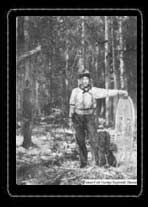
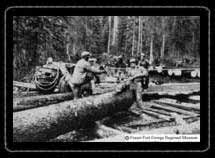
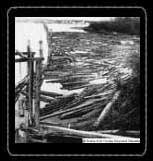

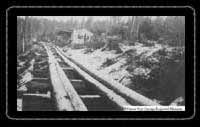
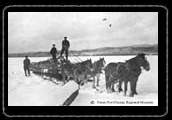
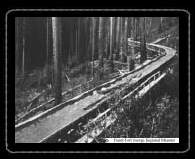

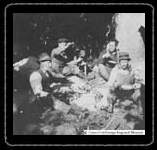
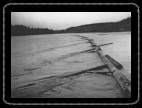
Canada's Digital Collections - Home - People
- Museum - Sources - Feedback
- Glossary
Beginnings - Lheidli T'enneh
- Meeting of Two Cultures - The Pioneer Experience
Logging - Railway
- Sternwheelers - The Northern Hotel
Logging techniques have changed much over the years, and harvesting logs wasn’t introduced with the advent of the railroad. The First Nations logged wood for dwellings and cleared areas to promote vegetation growth. They logged by digging below the tree and burning the roots. Stone, bone or antler tools were used to remove branches.
In Prince George the first sawmills, set up by Nick Clark in 1910 obtained all their logs from land cleared to develop the booming township. Land was selling for $10,000 an acre (Drushka). Trees were felled, man-handled with peaveys (levers) and jackscrews, transported to water, and then boomed and towed to the mills. The lumber was then used by the settlers to build their town.
In Prince George, it was hard to log year-round because in winter one couldn't count on freezing weather, and in summer, dry ground conditions were unpredictable. Sinclair McLean adapted the logging techniques used elsewhere to suit the regional conditions and invented some new ones.
Horses were used to haul logs to the river on "pole roads," shown at the end of the page. Logs were loaded on a wooden frame which slid along greased rails. They used this method on hauls of three kilometres or less. For longer distances (5–6km) cast-iron wheels were put on the frame; they called these "pole cars."
Some pole roads were built to the Grand Trunk Pacific main line. Most went to the Fraser River, where the logs were floated down to the mill, or hauled by sleigh to the frozen river and decked along its banks. After the ice went out, they were loaded onto the river and floated to the mill.
McLean built a system of fin booms which were used to direct logs around sand bars, rocks, and towards the mill pond (Drushka) .
During booming season, river rats patrolled the booms and adjusted the fins, broke up log jams and cleared logs off bars and rocks. The fin booms had to be removed from the river at freeze-up and replaced during the spring break-up.
Loggers would get up at dark, three to a group. The first man, the faller, cuts the trees, the second man limbs the trees, and the third uses horses to haul the logs to the edge of the water.
Logging takes place in the winter when the logs can be piled on frozen lakes and rivers, called decks.
When the water began flowing, the logs floated down river. The river drivers used hooks—peaveys—to move the logs along the river to the sawmill.
"Alibi day" = pay day, as loggers had to find excuses to go to town and spend their money.
"Take a dose of hike" = you've been fired.
"Misery whip/harp" = crosscut saw.
"Time to dung out " = clean up your mess (comes from when horses were used in logging, and the men had to clean their stables.)
"He's a good hand at flipping the chips" = he's good at using an axe.
"Monthly insult" = paycheque.
Logging - Railway
- Sternwheelers - The Northern Hotel
Beginnings - Lheidli T'enneh
- Meeting of Two Cultures - The Pioneer Experience
Canada's Digital Collections - Home - People -
Museum - Sources - Feedback
- Glossary